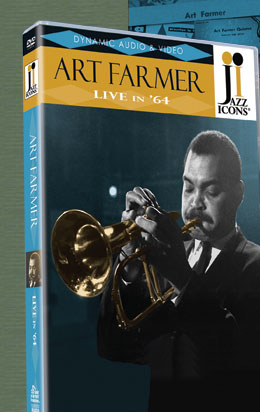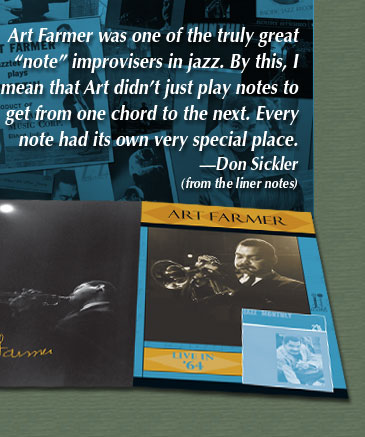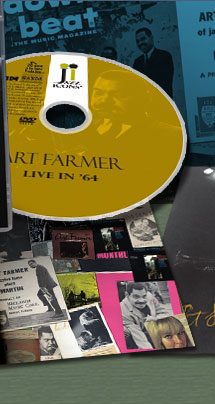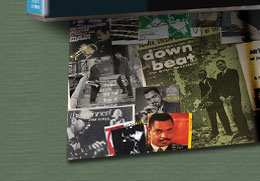|

Sample Liner Notes by Don Sickler:
The Art Farmer Quartet
A horn quartet with guitar has a distinctive sound, different from a quartet with piano. If you’ve heard any of the great recordings Art Farmer did with the Gerry Mulligan Quartet (1958), you’ll know that Art enjoyed the two-horn, piano-less quartet sound. The Art Farmer Quartet with Jim Hall, two instrumentalists with individual and intimate sounds, is unique. First of all, Art plays flugelhorn exclusively, rather than trumpet. The flugelhorn, with a bigger bell than the trumpet, has a deeper, darker and warmer sound. Art knew it would blend well with the guitar. Second, although the guitar can certainly be a chordal instrument, and “comp” (accompany) behind the soloists, it’s also a great linear instrument, and the blend of the timbre of flugelhorn and guitar linear lines was also very appealing to Art. Plus, the guitar can at any time switch from playing linear melody to playing chords, further expanding the sonic palette.
Jim Hall
Here is what Art said about Jim Hall:
“What appeals to me about Jim’s playing? Well, just from a subjective point of view: apart from his being a great soloist, who is able to create beautiful melodic phrases — he makes me sound good! He’s the greatest person out here for that; I don’t know anyone who is as quick in his head as Jim, that he can complement whatever direction that the soloist wants to go — it seems like he almost anticipates you. He never overdoes it, and he knows just how to put that little seasoning in there — whatever the situation calls for, he knows what to do. I don’t hear that from anyone else.
“You never have to tell him to do it this way or that way. And you can go to work with him and play a song that you never have played before without any fear of what’s going to happen with it. You never think: ‘Well, maybe we should have rehearsed first.’ It just happens sort of spontaneously. Not to say that we didn’t rehearse when we were going to make a record: someone might have an idea in a club of a song to try; so we’d try it on the gig, and if we liked it and we decided we wanted to put it on a record, then we’d spent some time exploring some possibilities with it. But the first time we play it, it’s already good.”
To complement the flugelhorn and guitar, Art needed a sensitive bass player and drummer, players who were really into a quartet concept. Steve Swallow and Pete LaRoca were Art’s choices.
Steve Swallow
In 1960, while studying at Yale University, Steve Swallow met Paul and Carla Bley. Steve left Yale for New York, where he began to tour and record with Paul Bley, the Jimmy Giuffre Trio and George Russell’s sextet. He joined the Art Farmer Quartet in 1963 and recorded with the group through their last recording in 1965.
Pete LaRoca
When he was 19 years old, Pete LaRoca started his jazz recording career with a Sonny Rollins date for Blue Note Records in 1957. Pete worked and recorded with Steve Swallow starting in August 1962, with the Paul Bley trio and then with George Russell’s sextet. Pete’s first complete recording with the Art Farmer Quartet was To Sweden With Love in April 1964, but the quartet had recorded one track two weeks earlier behind the singer Anamari for Atlantic Records. He also was on the last quartet recording in 1965.
******
5) So In Love
This is an AABA long form composition. Each section is longer than the usual eight bars. The first two A sections are 16 measures each, and the second A goes in a different direction starting in the tenth measure. The bridge (B) is also 16 measures. The last A section starts like the opening A section but in the 10th measure changes directions again, for a third time, and keeps weaving and extending. The last A is 24 measures long.
Some jazz artists do try to solo on this whole form: 16-16-16-24. Others, including this quartet, shorten the last A section to 16 measures. Less complicated, although there’s still a lot to think about to keep the chord progression straight in your brain so you don’t take any wrong turns while soloing. This is another tour de force performance by the group. It’s obviously not just a jam-at-the-moment choice; they had played it before, as you can tell by the worked-out ending. After playing the melody, Art takes two choruses, then Jim takes two choruses, then Art starts to trade whole choruses with the drums: Art - Pete - Art - Pete - Art - Pete and then Art restates the melody for their ending. Interestingly, I have found no other recordings of this song by any members of this quartet.
6) I’m Getting Sentimental Over You
This is Jim’s feature, as it was when the band recorded the Live At The Half Note session. A comparison of the two performances, however, further emphasizes Jim’s flexibility. He sets a slower groove on this performance. Although he takes the other two musicians on basically the same path, starting in the key of F, then modulating to the key of D-flat, and then modulating back to the key of F, he keeps the other two trio members thinking as he constantly invents new ways to explore his arrangement. I found that Jim did record this song one other time, a couple of years earlier, in a duet context with Bill Evans.
Back to top of page
All words and artwork on this page ©Reelin' In The Years Productions. Unauthorized use is prohibited.
|










